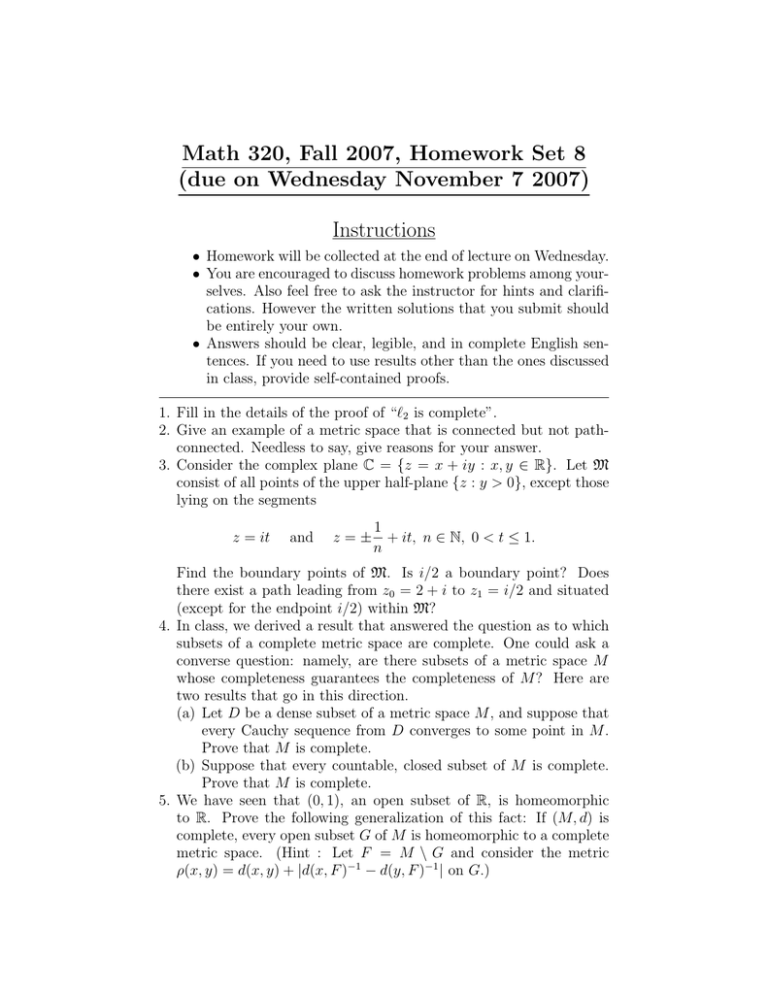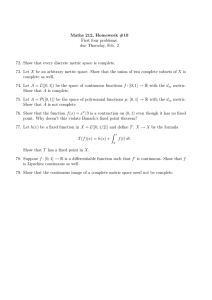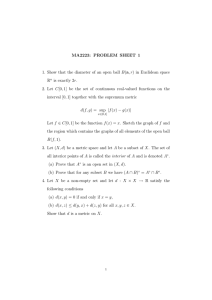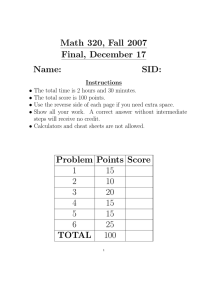Math 320, Fall 2007, Homework Set 8 Instructions
advertisement

Math 320, Fall 2007, Homework Set 8
(due on Wednesday November 7 2007)
Instructions
• Homework will be collected at the end of lecture on Wednesday.
• You are encouraged to discuss homework problems among yourselves. Also feel free to ask the instructor for hints and clarifications. However the written solutions that you submit should
be entirely your own.
• Answers should be clear, legible, and in complete English sentences. If you need to use results other than the ones discussed
in class, provide self-contained proofs.
1. Fill in the details of the proof of “`2 is complete”.
2. Give an example of a metric space that is connected but not pathconnected. Needless to say, give reasons for your answer.
3. Consider the complex plane C = {z = x + iy : x, y ∈ R}. Let M
consist of all points of the upper half-plane {z : y > 0}, except those
lying on the segments
z = it
and
z=±
1
+ it, n ∈ N, 0 < t ≤ 1.
n
Find the boundary points of M. Is i/2 a boundary point? Does
there exist a path leading from z0 = 2 + i to z1 = i/2 and situated
(except for the endpoint i/2) within M?
4. In class, we derived a result that answered the question as to which
subsets of a complete metric space are complete. One could ask a
converse question: namely, are there subsets of a metric space M
whose completeness guarantees the completeness of M ? Here are
two results that go in this direction.
(a) Let D be a dense subset of a metric space M , and suppose that
every Cauchy sequence from D converges to some point in M .
Prove that M is complete.
(b) Suppose that every countable, closed subset of M is complete.
Prove that M is complete.
5. We have seen that (0, 1), an open subset of R, is homeomorphic
to R. Prove the following generalization of this fact: If (M, d) is
complete, every open subset G of M is homeomorphic to a complete
metric space. (Hint : Let F = M \ G and consider the metric
ρ(x, y) = d(x, y) + |d(x, F )−1 − d(y, F )−1 | on G.)
2
6. Preface. Completeness is a useful property to have around if you
are interested in solving equations. How so? Well, given an equation, we can start out by finding an approximate solution, and then
look for ways to improve our estimate. If our sequence of “better
and better” approximations is in fact Cauchy, by virtue of completeness of the underlying metric space we have effectively solved our
equation. One such technique for displaying a Cauchy sequence of
approximate solutions is called the method of successive approximations. This problem deals with an example of this method, most
often referred to as the Banach contraction mapping principle.
A function f : M → M on a metric space (M, d) is called a strict
contraction if there is some constant α with 0 ≤ α < 1 such that
d(f (x), f (y)) ≤ αd(x, y) for all x, y ∈ M.
That is, a contraction shrinks the distance between pairs of points
by a factor strictly less than 1. Banach’s approach seeks to solve an
equation of the form f (x) = x, i.e., we look for a fixed point for f .
Statement of the Problem. Let M be a complete metric space
and f : M → M be a strict contraction. Show that f has a unique
fixed point. In fact, given any point x0 ∈ M , the sequence of functional iterates {f (n) (x0 )} always converges to the fixed point for f .
(The notation f (n) means the composition of f with itself n times :
f ◦ f ◦ · · · ◦ f . For example f (2) (x) = f (f (x)), f (3) (x) = f (f 2 (x))
and so on.)





